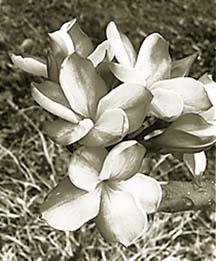


Ever Green

Photo courtesy of Jim Little
Plumerias have come a long way from the traditional pastel
colored and white blossoms, above. New varieties have
more brilliant coloring, such as the unnamed
rainbow cultivar below.
WHAT'S in a name? In botanical circles, confusion. Say a serious bougainvillea grower in Kona hybridizes two of his plants and creates a beautiful new flower that he names for his wealthy Aunt Agnes. Thrilled with the worldwide acceptance of her name on a new flower, she leaves him all her General Electric stock. Well, it's new to him, but somebody in Singapore and somebody else in South Africa made the same cross, got the same flower and named it for his secretary and his mother, respectively. (As with boats, people tend to give plants feminine names.) So we have one flower with three names. New plumerias in profusion
Among orchid growers, this can't happen because in 1906 a methodical English botanist named Sander began to publish a list of hybrids with the names of the parent plants and the hybridizers. The first hybrid registered is then the official one, and later growers of the same flower are notified that they are too late. The practice has since been taken over by the Royal Horticulture Society in London, but is still known as "Sander's List."

According to Jim Little, who is a commercial grower of plumerias, there is a similar if less organized list of plumeria hybrids kept in Houston, Texas, by the Plumeria Society of America. The problem, Little says, is that many plumeria crosses are random, through what is called "open pollination.""This means that the pollen can be transferred by the wind or insects or on dust, or the plant can even self-pollinate. A grower collects the seed pod, cultivates the seeds and ends up with seedlings that are identical to the parent, but he doesn't know this and he renames it. We nursery people see the duplication of names and the confusion that results when people try to identify and order a plant that may have several names," he said.
"When you make a cross, you set up a criteria for selection, you don't just keep everything and then name them for your boss or the dog. It's driving us bonkers. To make a superior cross, you use superior trees."
Little uses controlled hybridization to create his plumeria crosses, a delicate process of hand pollination taught to him in 1974 by the late William Moragne.
An executive in the sugar business on Kauai, Moragne is considered the pioneer in hybridizing plumeria. He made the first documented cross using the pollen of the small red plumeria named "Scott Pratt" on the flower of the large white "Daisy Wilcox" variety. The result was a total of four seed pods that produced 283 seedlings.
"Bill Moragne planted all of them, but he kept only the best, and he named those for his wife and daughters. There's a set of standards we use in judging what to keep. What you don't want is something similar to an existing flower. What you do look for is the size of the flower, its color and its fragrance. You want a flower that will have good texture, not be floppy, so it will last in a lei. Then you look at the foliage and the growth habit of the tree. It should be compact and not leggy. You want shiny dark green leaves so that it looks good when it's not in flower," Little said.
"I taught art and photography, and I used to quote Picasso who said, 'I'll paint 100 paintings and I'll keep only one. An amateur keeps 99 of his.' It's the same with plumeria."
Little names only the best of his plants, the others are numbered, but he is saving the name of his wife, Doric, for the absolutely best of his hybrids. None has yet earned the name, but when it does it will probably be a true orange, which so far does not exist.
"I don't particularly favor the whites and the pastels," he said. "I like the rainbow plumeria and the bright, strong colors. There are hundreds of new colors, intense yellows and strong reds. The more crosses you make, the stronger the colors become. Most of my crosses are made with the original Moragne hybrids."
So when you buy a dried cutting of plumeria, or a seedling not in flower, ask to see a photograph of what the flower will be. There are many new cultivars that are replacing the standard "graveyard flowers" of 50 years ago.
The state's biggest and best orchid show, the 60th Annual Orchid Show and Plant Sale sponsored by the Honolulu Orchid Society, is on now at the Neal Blaisdell Exhibition Hall. It will close Sunday. In keeping with the theme of the show, each orchid club on Oahu has been invited to create a display celebrating the ethnic background and the history of the club and its members.
This is dependably a magnificent experience that includes lectures by growers, a lei contest using dendrobium orchids and a great plant sale. Don't miss it.
NA OKIKA O HAWAII -- 60 YEARS
What: Show sponsored by the Honolulu Orchid Society
Where: Neal Blaisdell Exhibition Hall
When: Today and tomorrow (Friday and Saturday) from 9 a.m. until 9 p.m., Sunday from 9 a.m. to 4 p.m.
Admission: Free
Gardening Calendar in Do It Electric!
Send queries along with name and phone number to:
Evergreen by Lois Taylor, Honolulu Star-Bulletin, P.O. Box 3080, Honolulu 96802.
Or send e-mail to features@starbulletin.com.
Please be sure to include a phone number.
Evergreen by Lois Taylor is a regular Friday feature of the
Honolulu Star-Bulletin. © 1998 All rights reserved.